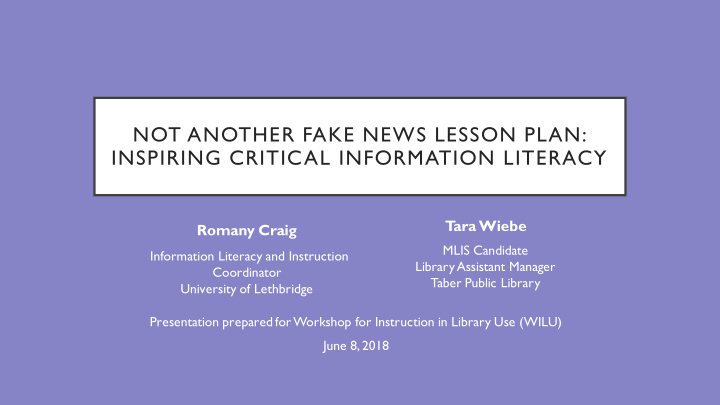



NOT ANOTHER FAKE NEWS LESSON PLAN: INSPIRING CRITICAL INFORMATION LITERACY T ara Wiebe Romany Craig MLIS Candidate Information Literacy and Instruction Library Assistant Manager Coordinator Taber Public Library University of Lethbridge Presentation prepared for Workshop for Instruction in Library Use (WILU) June 8, 2018
CONTEXT • University of Lethbridge Library • Co-op student placements • 8 months • Variety of experience: member of teams and work groups, collection management, reference, instruction, professional development opportunities • LBSC 2000 Library Research and Information Systems and LBSC 0520 Information Literacy • Credit courses • Taught by librarian
EVALUATING SOURCES, FAKE NEWS, AND NEWS LITERACY – OH MY! Critique of acronym and checklist models A) Failed connections to daily life practices, especially in social media environments – still too cumbersome B) Centered on traditional publishing and dissemination I. Use of diverse primary source material II. Different degrees of quality within different source types C) Psychological and social component of information consumption underemphasized
TEACHING THE PERSONAL PRACTICE OF EVALUATING SOURCES Active learning strategies "Education must begin • Demonstrable engagement with lesson with the solution of the • Practice applying new approaches teacher-student contradiction, by • Learning from peers/ teaching peers reconciling the poles of Reflection the contradiction so • Focus attention on own process and assumptions that both are • Understanding and creating meaning from simultaneously teachers experience and students." (Freire, 1970, 59) • Identification of critical questions
LESSON PLAN: INTRO SETTING THE RIGHT TONE • Disrupt “expert” authority • Modelling • Context as influence • Process of analysis • Not always right 100% of the time • Critical self-reflection and learning
LESSON PLAN: INTRO SETTING THE RIGHT TONE • Narrative that reflects common experiences • Highlights social and psychological factors • Models process of self- reflection and ongoing learning • Prepares for pre-test
LESSON PLAN: PRE-TEST 2 minute response writing • Voluntary group share
LESSON PLAN: ACTIVITY 1) Background information • Short lecture with illustrative slides 2) Group news evaluation: “imagine a trusted friend sent you this article, how do you evaluate it? Is it real or fake?” • 4 different articles from different points along the continuum • Set up for an extension of learning about different motivations or interests informing news coverage and false news creation • Examples range from local to global 3) Share process and determination with class • Draw attention to the unique concerns within each article Source: https://firstdraftnews.com/fake-news-complicated/
LESSON PLAN: POST-ASSESSMENT • Write-Pair-Share • Quick write “What criteria or strategies can you use to evaluate a news source?” • Share with a partner • Share with the group to create a comprehensive list of strategies we can use
ANALYSIS OF STUDENT RESPONSES Confirmation bias • "I fall hook, line and sinker for stupid stories, especially positive ones because I want to believe there is good in the world." Filter bubble • "They try to personalize the information to something related to me." Spectrum of misinformation • "I feel people are getting a lot smarter and clever about how to write article headlines that seem 'real.'"
Student Write-Ups: LS 0520 No Mentions of Key 15 Concepts Fake News Spectrum 0 Filter Bubble 1 Confirmation Bias 2 0 2 4 6 8 10 12 14 16
Student Write-Ups: LS 2000 #1 No Mentions of Key 12 Concept Fake News Spectrum 6 Filter Bubble 0 Confirmation Bias 0 0 2 4 6 8 10 12 14
Student Write-Ups: LS 2000 #2 No Mentions of Key 14 Concepts Fake News Spectrum 2 Filter Bubble 0 Confirmation Bias 1 0 2 4 6 8 10 12 14 16
COMPARING RESPONSES Confirmation Bias/Filter Bubble: • Focus on significance of critically evaluating not only the source of an article itself, but the source within one’s own social media context • Importance of triangulation Fake News Spectrum: • Students could view articles with nuance (i.e - source is legitimate, but there are bias issues; article seems slightly sensationalist, but other sources confirmed the story’s information)
INSTRUCTOR REFLECTIONS Strengthening emphasis on key concepts through the writing prompt • Make direct connections to psychological biases through the prompt question Students sometimes needed a push to move beyond "good enough" evaluation • Making information literacy more of a holistic process
CRITIC AL EVALUATION BEYOND THE CHECKLIST MODEL
ACTIVATING PRE-EXISTING SKILLS • Many current undergraduates are digital natives – they are very familiar with the internet • Students are already researchers with unique experiences – asking them to incorporate their backgrounds into the research process can be very effective • Activating and building on skills students already have encourages critical evaluation of sources in their daily lives
TO SUM IT ALL UP… • Checklists, while a useful tool, do not account for psychological reasons that people fall for fake news, such as the confirmation bias and social media filter bubbles. • Checklist usage does not mimic real life internet behavior. • Students aren’t blank slates – they come to class with their own backgrounds and set of skills. Active learning strategies and class collaboration helps students build on their own budding research capacities.
Thank you for listening! Questions?
REFERENCES Cooke, N. A., Barclay, D., & Burkhardt, J. M. (Panel). (November 1, 2018). Tackling fake news: An American Libraries Live webcast [Webinar]. Retrieved from https://americanlibrariesmagazine.org/al- live/ Freire, P. (1970). Pedagogy of the oppressed . New York, NY: Herder and Herder.
IMAGE SOURCES 7 types of mis and disinformation. Retrieved from: https://firstdraftnews.com/fake-news-complicated/
Recommend
More recommend